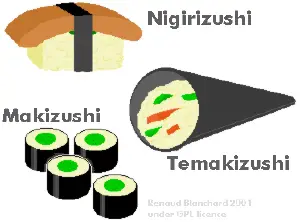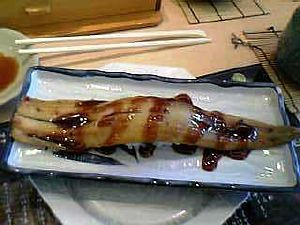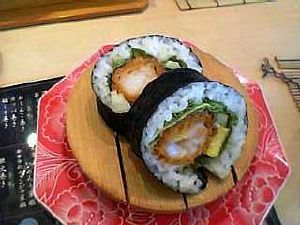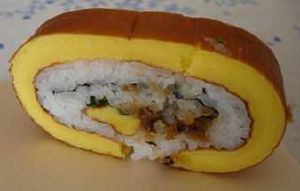Difference between revisions of "Sushi" - New World Encyclopedia
Keisuke Noda (talk | contribs) (imported from wiki) |
m ({{Contracted}}) |
||
| Line 1: | Line 1: | ||
| − | + | {{Contracted}} | |
In [[Japanese cuisine]], '''sushi''' is a [[food]] made of [[vinegar]]ed [[rice]] combined with various toppings or fillings, which are most commonly [[seafood]] and can also include [[meat]], [[vegetable]]s, [[mushrooms]], or [[egg (food)|eggs]]. Sushi toppings may be raw, cooked, or marinated. | In [[Japanese cuisine]], '''sushi''' is a [[food]] made of [[vinegar]]ed [[rice]] combined with various toppings or fillings, which are most commonly [[seafood]] and can also include [[meat]], [[vegetable]]s, [[mushrooms]], or [[egg (food)|eggs]]. Sushi toppings may be raw, cooked, or marinated. | ||
Revision as of 21:24, 27 September 2006
In Japanese cuisine, sushi is a food made of vinegared rice combined with various toppings or fillings, which are most commonly seafood and can also include meat, vegetables, mushrooms, or eggs. Sushi toppings may be raw, cooked, or marinated.
Sushi as an English word has come to refer to the complete dish (rice together with toppings); this is the sense used in this article. The original term Japanese: 寿司 sushi (-zushi in some compounds sush as makizushi) in the Japanese language refers to the rice, not the fish or other toppings.[1]
In the Western world, sushi is often misunderstood to mean only clumps of rice topped with raw fish, or to refer to other raw-seafood dishes, such as sashimi (sushi and sashimi are considered distinct in Japan).
There are various types of sushi. Sushi served rolled in nori (dried sheets of laver, a kind of seaweed) is called maki (rolls). Sushi made with toppings laid onto hand-formed clumps of rice is called nigiri; sushi made with toppings stuffed into a small pouch of fried tofu is called inari; and sushi made with toppings served scattered over a bowl of sushi rice is called chirashi-zushi, or scattered sushi.
History
Types of sushi
The common ingredient in all the different kinds of sushi is sushi rice (simply sushi in Japanese). Variety arises in the choice of the fillings and toppings, the other condiments, and in the manner they are put together. The same ingredients may be assembled in various different ways, traditional and contemporary.[2]
Nigiri
- Nigiri-zushi (握り寿司, lit. hand-formed sushi). Arguably the most typical form of sushi at restaurants, it consists of an oblong mound of sushi rice which is pressed between the palms of the hands, with a speck of wasabi and a thin slice of a topping (neta) draped over it, possibly bound with a thin band of nori. Assembling nigiri-zushi is surprisingly difficult to do well. It is sometimes called Edomaezushi, which reflects its origins in Edo (present-day Tokyo) in the 18th century. It is often served two to an order.
- Gunkan-maki (軍艦巻, lit. warship roll). A special type of nigiri-zushi: an oval, hand-formed clump of sushi rice (similar to that of nigiri-zushi) that has a strip of nori wrapped around its perimeter to form a vessel that is filled with the topping. The topping is typically some soft ingredient that requires the confinement of the nori, for example, roe, natto, or (a contemporary fusion) macaroni salad. The gunkan-maki was invented at Kyubei restaurant (est. 1932) in Ginza and its invention significantly expanded the repertoire of soft toppings used in sushi.
Maki (roll)
- Makizushi (巻き寿司, lit. rolled sushi). A cylindrical piece, formed with the help of a bamboo mat, called a makisu. Makizushi is generally wrapped in nori, a sheet of dried pressed laver (a kind of seaweed) that encloses the rice and fillings, but can occasionally be found wrapped in a thin omelette.[1] Makizushi is usually cut into six or eight pieces, which constitute an order.
- Futomaki (太巻き, lit. large or fat rolls). A large cylindrical piece, with the nori on the outside. Typical futomaki are three or four centimeters diameter. They are often made with two or three fillings, chosen for their complementary taste and color. During the Setsubun festival, it is traditional in Kansai to eat the uncut futomaki in its cylindrical form.
- Hosomaki (細巻き, lit. thin rolls). A small cylindrical piece, with the nori on the outside. Typical hosomaki are about two centimeters thick and two centimeters wide. They are generally made with only one filling.
- Kappamaki, a kind of hosomaki filled with cucumber, is named after the Japanese legendary water imp fond of cucumbers, the kappa (河童).
- Tekkamaki (鉄火巻き) is a kind of hosomaki filled with tuna. "Tekka" (鉄火) is a Japanese casino and also describes hot iron, which has a color similar to the red tuna flesh.
- Uramaki (裏巻き, lit. inside-out rolls). A medium-sized cylindrical piece, with two or more fillings. Uramaki differ from other maki because the rice is on the outside and the nori within. The filling is in the center surrounded by a liner of nori, then a layer of rice, and an outer coating of some other ingredient such as roe or toasted sesame seeds. Typically thought of as an invention to suit the American palate[2], uramaki is not commonly seen in Japan. The California roll is a popular form of uramaki. The increased popularity of sushi in North America, as well as around the world, has resulted in numerous different kinds of uramaki and regional off-shoots being created. Regional types include the B.C. roll (salmon) and Philadelphia roll (cream cheese).
- Temaki (手巻き, lit. hand rolls). A large cone-shaped piece, with the nori on the outside and the ingredients spilling out the wide end. A typical temaki is about ten centimeters long, and is eaten with the fingers since it is too awkward to pick up with chopsticks.
- Inari-zushi (稲荷寿司, stuffed sushi). A pouch of fried tofu filled usually with just sushi rice. It is named after the Shinto god Inari, whose messenger, the fox, is believed to have a fondness for fried tofu. The pouch is normally fashioned from deep-fried tofu (油揚げ or abura age). Regional variations include pouches made of a thin omelet (帛紗寿司 (hukusa-zushi) or 茶巾寿司 (chakin-zushi)) or dried gourd shavings (干瓢 or kanpyo).
Oshizushi
- Oshizushi (押し寿司, lit. pressed sushi). A block-shaped piece formed using a wooden mold, called an oshibako. The chef lines the bottom of the oshibako with the topping, covers it with sushi rice, and presses the lid of the mold down to create a compact, rectilinear block. The block is removed from the mold and cut into bite-sized pieces.
Chirashi
- Chirashizushi (ちらし寿司, lit. scattered sushi). A bowl of sushi rice with the other ingredients mixed in. Also referred to as barazushi.
- Edomae chirashizushi (Edo-style scattered sushi) Uncooked ingredients artfully arranged on top of the rice in the bowl.
- Gomokuzushi (Kansai-style sushi). Cooked or uncooked ingredients mixed in the body of the rice in the bowl.
Narezushi (old style fermented sushi)
- Narezushi (熟れ寿司, lit. matured sushi) is an older form of sushi. Skinned and gutted fish are stuffed with salt then placed in a wooden barrel, doused with salt again, and weighed down with a heavy tsukemonoishi (pickling stone). They are salted for ten days to a month, then placed in water for 15 minutes to an hour. They are then placed in another barrel, sandwiched, and layered with cooled steamed rice and fish. Then this mixture is again partially sealed with otosibuta and a pickling stone. As days pass, water seeps out, which must be removed. Six months later, this funazush can be eaten, and it remains edible for another six months or more.
Sushi gallery
- Sushi3.jpg
Futomaki (太巻き)
- Sushi1.jpg
California Roll /Uramaki (カリフォルニア巻き)
- California roll with tobiko.jpg
California Roll /with tobiko (飛び子)
- DragonRoll.JPG
Dragon Roll (US style eel roll)
- 450px-Inari.jpg
Inari Sushi (稲荷寿司)
Kakinoha (Persimmon leaf) Sushi (柿の葉寿司)
Ingredients
All sushi has a base of a specially prepared rice, complemented with other ingredients.
Sushi rice
Sushi is made with white, short-grained, Japanese rice mixed with a dressing made of rice vinegar, sugar, salt, kombu, and sake. It is cooled to body temperature before being used. In some fusion cuisine restaurants, short grain brown rice and wild rice are also used.
Sushi rice (sushi-meshi) is prepared with short-grain Japonica rice, which has a consistency that differs from long-grain strains such as Indica. The essential quality is its stickiness. Rice that is too sticky has a mushy texture; if it is not sticky enough, it feels dry. Freshly harvested rice (shinmai) typically has too much water, and requires extra time to drain after washing.
There are regional variations in sushi rice, and of course individual chefs have their individual methods. Most of the variations are in the rice vinegar dressing: the Tokyo version of the dressing commonly uses more salt; in Osaka, the dressing has more sugar.
Sushi rice generally must be used shortly after it is made. The Wiki Cookbook has a simple recipe.
Nori
The seaweed wrappers used in maki and temaki are called nori. This is an algae traditionally cultivated in the harbors of Japan. Originally, the algae was scraped from dock pilings, rolled out into sheets, and dried in the sun in a process similar to making paper. Nori is toasted before being used in food.
Today, the commercial product is farmed, produced, toasted, packaged, and sold in standard-size sheets, about 18 cm by 21 cm in size. Higher quality nori is thick, smooth, shiny, black, and has no holes.
Nori by itself is edible as a snack. Many children love flavored nori, which is coated with teriyaki sauce. However, those tend to be cheaper, lesser quality nori that is not used for sushi.
Omelette
When making fukusazushi, a paper-thin omelette may replace a sheet of nori as the wrapping. The omelette is traditionally made in a rectangular omelette pan (makiyakinabe), and used to form the pouch for the rice and fillings.
Toppings and fillings
- Fish
- For culinary, sanitary and aesthetic reasons, fish eaten raw must be fresher and of higher quality than fish which is cooked. A professional sushi chef is trained to recognize good fish, which smells clean, has a vivid color, and is free from harmful parasites. Only ocean fish are used raw in sushi; freshwater fish, which are more likely to harbor parasites, are cooked.
- Commonly-used fish are tuna, yellowtail, snapper, conger, eel, mackerel and salmon. The most valued sushi ingredient is toro, the fatty cut of tuna. This comes in varieties ōtoro (often from the bluefin species of tuna) and chutoro, meaning middle toro, implying it is halfway in fattiness between toro and regular red tuna (akami).
- Seafood
- Other seafoods are squid, octopus, shrimp, fish roe, sea urchin (uni), and various kinds of shellfish. Oysters, however, are not typically put in sushi because the taste is not thought to go well with the rice. However, some sushi restaurants in New Orleans are known to have Fried Oyster Rolls, and Crawfish rolls.
- Vegetables
- Pickled daikon radish (takuan) in shinko maki, various pickled vegetables (tsukemono), fermented soybeans (natto) in nattō maki, avocado in California rolls, cucumber in kappa maki, asparagus, yam, tofu, pickled ume (umeboshi), gourd (kampyō), burdock (gobo), and sweet corn mixed with mayonnaise.
- Red meat
- Note: It is a common misconception that in Hawaii, fried Spam is a popular local variation of sushi. In reality, Spam musubi differs from sushi in that its rice lacks the vinegar required to classify it as such. Spam musubi is correctly classified as onigiri.
- Other fillings
- Eggs (in the form of a slightly sweet, layered omelet called tamagoyaki), raw quail eggs riding as a gunkan-maki topping.
Condiments
- Shōyu
- Soy sauce.
- Wasabi
- The grated root of the wasabi plant. The best tool to use for grating wasabi is normally considered to be a sharkskin grater or samegawa oroshi. At cheap establishments like kaiten zushi restaurants, bento box grade sushi, and at most restaurants outside of Japan, imitation wasabi (seiyo-wasabi) made of horseradish sometimes processed in Japan (allows the use of "Japanese Horseradish" on the label), mustard powder, and FD&C Yellow #5 and Blue #1.[3] Real wasabi (hon-wasabi) is wasabi japonica, a different rhizome from european horseradish. Hon-wasabi has been found to have antimicrobial properties and its consumption with raw fish is believed to help prevent bacterial food poisoning.[4]
- Gari
- Sweet, pickled ginger. Gari (ginger) is eaten to both cleanse the palette as well as to aid in the digestive process.
Presentation
In Japan, and increasingly abroad, conveyor belt sushi/sushi train — kaiten zushi) restaurants are a popular, cheap way of eating sushi. At these restaurants, the sushi is served on color-coded plates, each color denoting the cost of that piece of sushi. The plates are placed on a conveyor belt or boats floating in a moat. The belt or boat passes the sushi by the customers who can pick and choose what they want. After finishing, the bill is tallied by counting how many plates of each color have been taken. Some kaiten sushi restaurants in Japan operate on a fixed price system, with each plate, consisting usually of two pieces of sushi, generally costing ¥100.
More traditionally, sushi is served on minimalist Japanese-style, geometric, wood or lacquer plates which are mono- or duo-tone in color, in keeping with the aesthetic qualities of this cuisine. Many small sushi restaurants actually use no plates — the sushi is eaten directly off of the wooden counter, usually with one's hands, despite the historical tradition of eating nigiri with chopsticks.
Modern fusion presentation, particularly in the United States, has given sushi a European sensibility, taking Japanese minimalism and garnishing it with Western gestures such as the colorful arrangement of edible ingredients, the use of differently flavored sauces, and the mixing of foreign flavors, highly suggestive of French cuisine, deviating somewhat from the more traditional, austere style of Japanese sushi.
Utensils for preparing sushi
- Fukin: Kitchen cloth.
- Hangiri: Rice barrel.
- Hocho: Kitchen knives.
- Makisu: Bamboo rolling mat.
- Ryoribashi: Cooking chopsticks.
- Shamoji: Wooden rice paddle.
- Makiyakinabe: Rectangular omelet pan.
Also see the comprehensive list of Japanese cooking utensils.
Guinness World Records
- January 1992. A 325 kg (715 lb) Bluefin tuna sold for $83,500 (almost $257 / kg or $117 / lb) in Tokyo, Japan. The tuna was reduced to 2,400 servings of sushi for wealthy diners at $75 per serving. The estimated takings from this one fish were approximately $180,000. At the time, the fish held the record for Most Expensive Fish.
- October 12, 1997: The longest sushi roll. Six hundred members of the Nikopaka Festa Committee made a kappamaki (cucumber roll) that was 1 km (3,279 ft.) long at Yoshii, Japan.
ReferencesISBN links support NWE through referral fees
- ↑ Barber, Kimiko;Takemura, Hiroki (2002). Sushi: Taste and Technique. DK Publishing. ISBN 0-7894-8916-3.
- ↑ Kawasumi, Ken (2001). The Encyclopedia of Sushi Rolls. Graph-Sha. ISBN 4-88996-076-7.
- ↑ Shimbo, Hiroko (2000). The Japanese Kitchen. The Harvard Commons Press. ISBN 1-55832-176-4.
- ↑ Shin, I.S. and Masuda H., Naohide K. (Aug 2004). Bactericidal activity of wasabi (Wasabia japonica) against Helicobacter pylori.. Int J Food Microbiol. 94 (3): 255-61.
See also
- List of sushi and sashimi ingredients and styles
- Hanaya Yohei
- Sashimi
- South Korean Sushi (Gimbab, 김밥)
- Japanese Dining Etiquette
External links
- Sushi Cookbook
- Sushi recipes
- How many calories are in sushi?
- The Sushi Eating HOWTO
- World-Wide Sushi Restaurant Reference
- What requirements must be met for fish to be designated as "sushi-grade"?
- Sushi Glossary
- The Sushi FAQ - (The alt.food.sushi Usenet group FAQ)
- Sushi Gallery
- How to eat Sushi
- How Sushi Works
ar:سوشي ca:sushi cs:Suši da:Sushi de:Sushi es:Sushi eo:Suŝio fi:Sushi fr:Sushi ko:초밥 he:סושי id:Sushi it:Sushi ja:寿司 lt:Sušis ms:Sushi nl:Sushi no:Sushi pl:Sushi pt:Sushi ru:Суши simple:Sushi sv:Sushi th:ซูชิ tr:Suşi zh-yue:壽司 zh:寿司
Credits
New World Encyclopedia writers and editors rewrote and completed the Wikipedia article in accordance with New World Encyclopedia standards. This article abides by terms of the Creative Commons CC-by-sa 3.0 License (CC-by-sa), which may be used and disseminated with proper attribution. Credit is due under the terms of this license that can reference both the New World Encyclopedia contributors and the selfless volunteer contributors of the Wikimedia Foundation. To cite this article click here for a list of acceptable citing formats.The history of earlier contributions by wikipedians is accessible to researchers here:
The history of this article since it was imported to New World Encyclopedia:
Note: Some restrictions may apply to use of individual images which are separately licensed.













